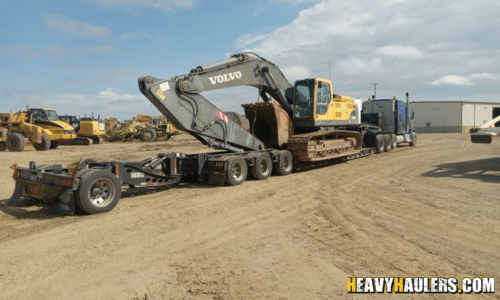When transporting heavy equipment, machinery or goods, what matters most is safety during transit. Ensuring the safety of heavy shipments and people involves knowing how to tie down equipment on a trailer for transport to ensure the machinery is delivered safely.
Cargo securing is a vital regulation that the Department of Transportation (DOT) and other transportation agencies such as FMCSA consider before allowing the transportation of heavy equipment, machinery, or vehicles. There are several fastening methods that transport companies and truck drivers can use when transporting heavy things.
What are the types of trailer hitches that carry oversized loads?
Trailers carrying heavy goods and equipment comply with DOT and FMCSA regulations that require truck drivers to use four tiedowns to ensure asset safety and support numerous forces along the road during transit. Below are some fasteners you can use to secure your equipment during transport within or outside the country.
1. Ratchet straps
Also known as tie downs, ratchet straps are known for their high durability, quality and strength. They can safely hold heavy equipment on a trailer while transporting large loads. Versatile ratchet straps securely tie different loads, equipment or machinery of various types, shapes, sizes and weights to their destinations.
Choosing the right straps depends on the size and weight of your car or equipment. Heavy haulers and truck drivers use straps as a method of securing equipment when:
- Placing equipment or heavy goods on the trailer platform
- Tie the tarpaulins to ensure that the load stays in one place
- Transport of light to heavy loads by land, sea or air
- Secure the items in the luggage racks of the vehicles
- Transport of cars and boats in trailers
2. Chains
You can also use chains to secure or secure heavy things, such as machines, vehicles, and farm or construction equipment, onto or from trailers when using variations of transport and shipping.
The attachment chains are durable and robust and prevent abrasion of your equipment during transit. They range from grades 30 to 120 (G30 to G120). The more degrees, the better the lifting or mooring chain because of its strength. For example, G100 and higher chains are best for heavy duty.
Chain gear attachment methods are applicable when:
- Movement of heavy vehicles or machines
- Towing or lighting heavy things
- Securing containers or cargo to the flat bed of a trailer
- Sea, air or road transport of goods

What are anchor points on trailers and how do you use them?
Truck drivers and other heavy transport companies should know the attachment points of a trailer to ensure that they load things, machinery and equipment safely for traffic. Trailer anchor points are anchor points that secure chains or straps to the truck.
Learning how to tie down equipment on a trailer is easier if you know the exact locations to consider when securing your load. The strategic location allows you to tie straps, chains, ropes and other fastening tools that hold the load securely on a trailer.
You can use the following attachment points to simplify transportation with different transportation and shipping methods.
- Single point anchors: It helps to mount the load on a trailer. Points include movable anchors, welds or D-rings, and recessed anchors for surface mounting.
- Stains: These are attachment points for tying ropes to hold heavy loads.
- track system anchors: It helps to carry various things. They include an E-track, a low-profile track that allows you to strap down your machines or equipment for safety.
- Track O Ligaments: the anchors have a metal loop that you can attach ratchet straps to when securing your gear for variations in transport and shipping.
How to choose the best method for securing equipment during shipping
When choosing the best methods of securing equipment during shipping, it is advisable to have professional help from experts in the heavy transportation industry. The techniques you select should be able to secure your heavy equipment to the trailer during transport.
When learning how to tie your gear to a trailer, it’s essential to understand how to choose the best tie-down method for the heavy stuff you want to ship.
Here are some tips to help you choose the best equipment fixing techniques.
- Know the regulations: Regarding the different mooring methods, find out if they comply with state or federal regulations.
- Types of equipmentt: Knowing the type of equipment to be transported in terms of size, material and weight helps you select the best anchoring methods.
- Mode of transport: Different modes of transportation and shipping are vital when selecting a ligature technique. Knowing whether your shipment will be moving by air, water or road helps you choose unmatched lashing methods that will keep heavy equipment in place all the way to its destination.
- Choose the correct size ratchet chains and straps that meet your cargo security needs by measuring the size and weight of your gear before transporting it.

Get the best fastening services for your shipment!
Transporting goods or equipment in or out of the country requires you to ensure that the cargo will be safe and secure during transit. Certain attachment methods and points can help keep your machine, vehicle or farm equipment in place during the transport process.
The most common fastening methods in shipping are straps, chains, loops, ropes and cords. At Heavy Haulers, we can help you choose the most suitable fastening methods to ensure the safe delivery of your cargo to its destination.

